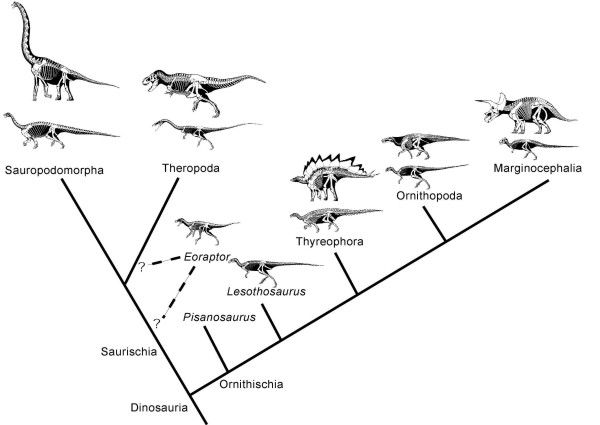GEOL 104 Dinosaurs: A Natural History
Fall Semester 2000
The Dinosaur Family Tree: What is a dinosaur (version 3)?
Dinosauria defined as all descendants of most recent common ancestor of Iguanodon
and Megalosaurus.

Dinosauria is divided into two clades, Ornithischia and Saurischia
Ornithischia (“bird hips”):
Defined as Iguanodon and all taxa closer to Iguanodon than to Megalosaurus
Diagnosed by presence of the predentary bone (an extra bone joining the two
anterior ends of the dentary, forming a beak) and five or more sacrals
All known ornithischians were most likely herbivores, with leaf-shaped teeth
Ischigualasto Formation of Argentina (Late Triassic): oldest and most primitive ]
known dinosaurs.
Most primitive known ornithischian is Pisanosaurus from the Ischigualasto.
All other, more derived ornithischians have a pubis that points backwards
(increases size of gut, allows better digestion of plant material).
Advanced thyreophorans include three major clades: Thyreophora, Ornithopoda,
and Marginocephalia.
Thyreophora:
Name means “shield bearer”
Armored dinosaurs: diagnosed by presence of rows of dermal ossifications
Early thyreophorans small (1 m long) bipedal animals; later forms much larger and
quadrupedal, with heavier armor
Ornithopoda:
Name means “bird foot”; a bit odd, as their feet aren't really bird-like
Specialized jaws:
- Premaxilla lower margin ventral to maxilla lower margin
- Jaw articulation ventral to maxilla tooth row
Early ornithopods small (1 m long) bipedal animals; later forms increase in size and
retain bipedality, but develop more sophisticated chewing jaws
Marginocephalia:
Name means “ridge head”
Characterized by shelf of bone extending back over occipital region of skull
Absent from fossil record until Middle Jurassic, and all but one known are Cretaceous
Primitive forms are bipedal; in one branch derived forms become very large and obligate quadrupeds
Marginocephalian skulls show a lot of suggestions of display and/or combat
The other major clade of dinosaurs is Saurischia:
Defined as Megalosaurus and all taxa closer to Megalosaurus than to
Iguanodon
Diagnosed by:
- Long necks where posterior cervicals are longer than anterior cervicals
- Manus with an enlarged digit I ungual (thumb claw)
- Manual digit II is the longest in the hand
Some saurischians retain the primitive carnivorous condition; others have
leaf-shaped teeth and were probably herbivores.
Saurischia is divided into two major clades, Sauropodomorpha and Theropoda.
Sauropodomorpha:
Name means “sauropod form”; Sauropoda means “lizard feet”, even though their feet do
not look much like lizard feet!
Characterized by:
- Enlarged nares
- An elongated neck
- Leaf-shaped teeth
Herbivores (early forms maybe omnivores)
Primitive forms are facultative bipeds; later forms were so large they were obligate
quadrupeds
Were the largest herbivores ever to live on land; by the end of the Late
Triassic had surpassed all previous land living animals in size, and kept on going…
From rocks of the same age as the Ischigualasto Fm., but in nearby Argentina, comes
Saturnalia, the most primitive known sauropodomorph. Possibly older sauropodomorphs
come from the ?Middle Triassic of Madagascar, but the age of the rocks is uncertain.
Theropoda:
Name means “beast foot”, after the curved claws
Characterized by extremely hollow limb bones
Most retain the primitive condition of bladelike, serrated teeth,
indicating they were carnivores
All, from smallest to largest, were obligate bipeds
Became the largest terrestrial carnivores of all time, but began at about 1 m long,
and even by end of Late Triassic were dwarfed by rauisuchians
In Ischigualasto Fm., a possible very primitive theropod Eoraptor. However,
is so primitive it might be a non-theropod saurischian, or a non-dinosaurian dinosauromorph.
Another Ischigualasto Fm. dinosaur is Herrerasaurus, member of
Herrerasauridae:
Has longer clutching fingers, shared with neotheropods (see below)
Has an intramandibular joint between the dentary and postdentary bones
- Absorbs the stresses of struggling prey
- Also found in neotheropods
Herrerasaurids were probably true theropods, but have only two sacrals (a
pre-dinosaur feature), have manual digit III longer than manual digit II (a pre-saurischian feature),
and have anterior cervicals as long or longer than posterior cervicals (another pre-saurischian feature)
So, they MIGHT be a non-theropod saurischian group
True, unquestioned theropods form the clade Neotheropoda
Name means “new theropods”
Have many synapomorphies:
- Promaxillary fenestra (an extra opening in the maxilla between the naris and
the antorbital fenestra)
- Five or more sacrals
- Furcula (clavicles fused into wishbone)
- Manual digit V lost: hand has only four fingers
- Pedal digits I and V reduced, so foot is functionally three-toed
By Late Triassic good fossils are known of Ornithischia, Sauropodomorpha, Eoraptor,
Herrerasauridae, and Neotheropoda.
To Next Lecture.
To Previous Lecture.
To Syllabus.

